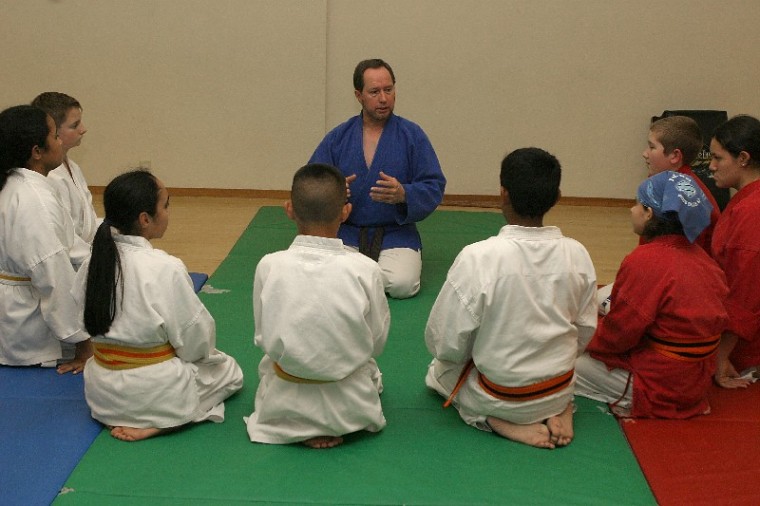Unique approach for different age levels
The Techniques Studio staff teaches martial arts in a unique
manner.
”
Many other studios are unrealistic in their expectations,
”
said Daniel Recht, director of operations.
Martial arts teach esteem
The Techniques Studio staff teaches martial arts in a unique manner.
“Many other studios are unrealistic in their expectations,” said Daniel Recht, director of operations.
“Their approaches are militaristic,” Recht said, “They are not at all age appropriate.”
Children and adults do not learn the same way, nor should they learn the same material, Recht said.
“Adults want more depth,” he said.
Some of their younger students come to them from other studios where they were trained as adults. One such student, a nine-year old female who is a natural athlete, was given training at her former studio that was inappropriate for her age. This included doing knuckle push-ups, Recht said.
“This exercise could damage the developing bursas under the knuckles of her fingers,” Recht said.
Recht has both textbook and first hand knowledge of this possibility. He studied physiology, anatomy, and kinesiology in college. Also, he had damaged his own bursas through repetitive knuckle push-ups.
In other studios a child who excels athletically may be placed in classes with much older students, Recht said.
At Techniques Studio students train with students of the same age and development. Students who are at a different stage than their peers would receive different training, Recht said.
“At a certain point in time, a specialized class might be needed,” Recht said.
At the studio in downtown Hollister new students are not automatically accepted.
First the prospective student is interviewed, as are the parents if the person is a child, Recht said.
They are asked what they hope to learn from the classes and their motivations. The life skills the studio teaches in addition to physical martial arts techniques are also discussed.
Recht and his head instructor Tim Gutierrez have each spent about 30 years studying aikido, gung fu, wing chun, and jiu jitsu, and derivatives of each, Gutierrez said.
“Public speaking is the number one fear of many people in America,” Recht said. At the studio they practice this skill and gain confidence, he said.
In class they discuss reactions and choices afterwards. The class thus allows students a chance to make mistakes and learn from them, Recht said.
Techniques Studios has multigenerational students. “We’ve had students come in and realized that we trained their parents and grandparents,” Recht said.
Paul Maxwell’s children are second-generation students. He has trained there for more than 12 years. His wife also trains there.
“The training offered here is different from anything else I’ve ever experienced,” Maxwell said.
One difference from other places is the amount of time spent talking with students. This takes the form of story time for children and discussion with the adults. They also participate in acting out real-life situations that they may deal with in the outside world, Recht said.
Children’s lessons include interacting with peers and adults and dealing with bullies and gangs. The studio places special attention on stranger awareness with “portions of an abduction being acted out,” Gutierrez said.
“We can create a scary thing within a controlled environment,” Recht said. “The students can experience adrenaline rush without the harm.”
Adults mainly learn about interactions with bosses and clients. They role play what to do if a boss or client does something in particular to practice in a friendly environment, Recht said.
One client, a corporate vice president would break out in a rash whenever she needed to make presentations. Her training focused on public speaking. Over time, she was less nervous, and was finally able to make effective speeches in her job, Recht said.
“We avoid learning by simple observation,” Gutierrez said, “Every aspect of what we do is discussed.”
Additionally with safety as a particular concern for children, much time is spent learning new moves in stages.
Maxwell’s daughter, Abigail, 10, started her training when she was 5.
“It’s only after coming here that she began speaking to people outside the family,” Maxwell said.
Techniques has helped other children interact with their peers. Melissa Casas looked for ways to help her son, DJ, 10, overcome his shyness, Casas said.
After DJ told his mom he wanted to try martial arts, the two of them visited several studios.
“I wasn’t fond of the style or approach at the other two,” Casas said. “It didn’t seem individualized, it seemed like he would blend into the huge crowd.”
Casas was especially impressed that they interviewed both her and DJ and took the time to see if it was the right program for them both, she said.
“It was harder to talk to people before,” DJ said. “We talk (in class) about how to be confident, how not to be scared to talk to people.”
His mother has seen other improvements in her son. He’s learned to stay focused and pay attention for a longer period of time, she said.
“Also, he’s learned to advocate for himself,” Casas said. “When he needs something, to sit in front of the class to listen and learn, he asks the teacher.”
**************************
Techniques Studios
211 Sixth S., Hollister
Mon., Wed. and Fri. 2:30 to 9 p.m.
Tue. and Thu. 9-11 and 2:30 to 9 p.m.
636-5566










